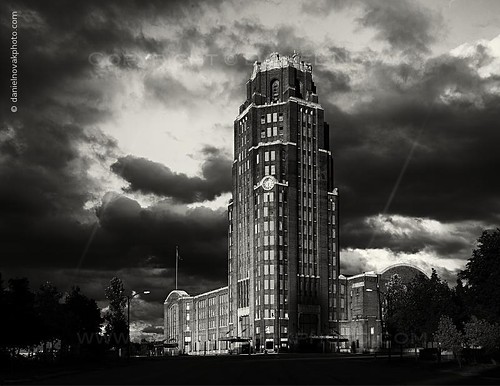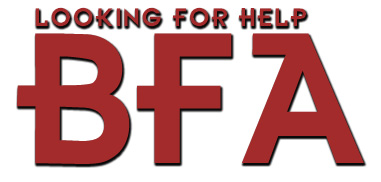The following is a guest post from Stephanie Perry, a fellow BU alumna, a former writer for the Daily Free Press, seen on Twitter at @stephperry. Last week, She began Tweeting about this topic and I asked if she would write something up for Artvoice.

Stormy over Buffalo Central Terminal by Daniel Novak at Flickr
Six months ago, a curious manifesto appeared on Buffalo Rising. This “concept proposal” was sweeping and ambitious, but hardly in the right ways. The writer proposed the mass relocation of Buffalo’s police and fire departments’ headquarters and of the region’s blue chip nonprofit service organizations to the worn but charming public market in the East Side’s Broadway-Fillmore neighborhood. Into the desirable mansions and buildings vacated by these public and charitable entities would go loft apartments and boutique hotels. Rich people would live in these nice properties while organizations that help disadvantaged people, many of whom are minorities, such as the International Institute, Child and Family Services and the United Way, would be sequestered in a distressed and racially segregated neighborhood that’s not easily accessible to the citywide population.
Private developers would make a killing on these new apartments and condos and return a bit under $800,000 annually to the city and county tax bases so that the city and county might provide services to the public, such as centrally located and publicly accessible police and fire departments, except not that anymore. Never mind that the city budget alone totals $1.4 billion. This is a plan to help the community help rich people help the community.
It would be nearly impossible to propose a more transparently self-serving plan to redistribute real property wealth to developers while simultaneously displacing organizations that have tirelessly served the community and maintained the architectural heritage of the Delaware District for decades. Plus, the short-sighted proposal is stock full of faulty assumptions about urban planning, crime and private property rights. Furthermore, the author’s inappropriate use of first-person perspective, sentence fragments and the conspicuous absence of facts together evoked the tone of a hastily composed high school civics project. I wondered who produced such an implausible, socially irresponsible and poorly written report. Was this the homework of some Rich Kid of Instagram?
The article’s byline was simply “Chris Jacobs,” the author bio at the bottom of the webpage blank. Chris Jacobs the county clerk? Chris Jacobs, whose erratic political resume suggests his most cherished platform is Keeping Chris Jacobs In Office? Chris Jacobs, nephew of the 185th richest person in America? The odd placement of this brazen but amateur civic proposal on a website mostly dedicated to critiquing storefront aesthetics and hip restaurants suddenly made sense. A very wealthy man of great self-appointed importance had an idea, and this narrative was almost inevitable. It is an election year for the county clerk. The idea was out there and it was only a matter of time before everyone was forced to respond to it. I set a Google news alert for key terms from the proposal and went about my life for half a year.
Finally, last Friday, it happened. Chris Jacobs’s poorly considered vanity proposal complete with professionally commissioned architectural renderings, landed on Page One of The Buffalo News. The only appropriate answer to the plan that imperils the stability of Delaware Avenue and downtown while disrespecting the work and property rights of nonprofit service organizations is “Thanks but no thanks,” and I find myself empathically supportive of the city’s reaction, as reported by the News, that “at this time the city has no plans” to act.
The article hints at the implausibility of the proposal —
Convince the city to move Police Headquarters to the East Side. Then do the same with the Fire Department.
Next, persuade the many nonprofits that occupy Buffalo’s grandest mansions along Delaware Avenue to pick up and move east, too.
Then sell the old headquarters and the mansions.
— but ultimately validates it more than any amount of billionaire blustering could. The article is predicated on the notion that the Jacobs proposal is worthy of consideration, which it is not, and that City Hall has an obligation to respond to and engage with him on the matter, which it also does not. As originally posted, the article lacked a link to the sloppy proposal Jacobs has been promoting and provided no assessment of its production quality. The News failed to ask Jacobs why he omitted from his list of nonprofit buildings best converted to private residences the UB Foundation-owned mansion that bears his family’s name.
The result is that Jacobs, who is peddling a steaming pile of bullshit, positions himself as a bipartisan populist concerned about the economic recovery of the East Side, while the mayor is an obstructionist, do-nothing fool. Few better narratives exist for campaign literature. (Imagine the flyer reading “Jacobs: Bold plan to boost East Side; City: ‘No plans to do that.’”) The Democratic challenger for county clerk has made an appropriate statement categorically rejecting Jacobs’s proposal. That anyone even needs to engage with this proposal is a travesty.
What makes it difficult to refuse to engage with Jacobs’s plan is that it presents explicit goals that are worthwhile to pursue: Yes, revitalizing distressed neighborhoods should be a civic goal. Yes, the East Side’s many neighborhoods deserve more attention from the county and city. Yes, grappling with the fact that an enormous portion of the property in Buffalo — particularly hospitals, churches, colleges, museums, schools, nonprofit foundations, even Buffalo Urban Renewal Agency-owned First Niagara Arena — is not taxable is a worthwhile endeavor. However, Jacobs’s plan is a poor one to achieve these worthy goals.
First, Jacobs claims that the strength of the downtown, Elmwood Village and Medical Campus Corridor real estate markets requires mansions and prime-location properties to be put “back in private hands and back on the tax rolls.” Aside from the fact that the claim that valuable real estate must belong to private investors is patently false, (how would any public agency exist in Manhattan were this the case?) the stability of downtown is hardly a foregone conclusion. One Seneca Tower competes with ubiquitous downtown parking lots for the title of most conspicuous under-utilized space in Buffalo. As many people have pointed out, nothing currently prevents private developers from making offers to nonprofits owning buildings they desire. For the right price, a move might be negotiated.
Jacobs’s list of nonprofits ripe for relocation is glaringly classist in its aims. The Red Cross, United Way, International Institute, Child and Family Services, Salvation Army, EPIC and the Catholic Center have strong commitments to aiding poor people. The real estate assets of at least some of these groups bolster their outreach and fundraising capabilities. The strongest example of this may the Buffalo branch of the American Red Cross, an organization that received its mansion at Delaware Avenue and Summer Street specifically as a philanthropic bequest from Carolyn Tripp Clement. Tours of the home not only raise money for the Red Cross but also make the beautiful structure publicly accessible. The Red Cross’s most significant fundraiser, the Mash Bash, takes place on the grounds of the mansion, without which the Red Cross would be unable to raise more than $352,000 in a single night.
The implicit goal of Jacobs’s proposal becomes clear when one considers what non-taxed entities with very fine real estate are omitted from his plan: Nardin Academy, Canisius High School, the Ronald McDonald House, the Jacobs Executive Development Center, Gilda’s Club, the County Clerk’s Office itself. Downtown, Elmwood and the Medical Corridor are too nice for poor people, according to Jacobs’s vision. Jacobs euphemistically says relocating service organizations to the Broadway Market would put those groups helping poor people “in closer proximity to those they serve.” In reality, the Broadway Market is less accessible than Delaware Avenue via public transportation for all but those in its immediate neighborhood.
Jacobs’s understanding of crime is fundamentally flawed but central to his proposal. While more densely populated urban neighborhoods generally are safer than those blighted with vacant properties and fewer residents, that busy areas guarantee public safety is oversimplified and confuses cause and effect. “More activity, more people, and more police would make this area begin to feel and to become safer. If people feel safe, many great things begin to happen, such as more people wanting to live in that community,” he claims. Public safety is a necessary condition for growth but no promise of it. And increased public safety itself is by no means a guaranteed outcome of having a police administration building in a neighborhood. Surveillance and safety are hardly synonymous despite the faulty claim that “not just the perception of more eyes on the neighborhood but the reality of more eyes on the neighborhood” will lead to increased safety. The origins of concentrated violence and crime in poor urban neighborhoods are far too complex to be solved by an eight-page development proposal.
The problems of Buffalo’s neighborhoods east of Main Street likewise are too complicated to be summed up by a poorly deployed Yogi Berra quote: “No one goes their anymore. It’s too crowded.” [There/their usage error from original document.] Jacobs refers to the East Side again and again as a monolith even though his proposal affects only one neighborhood, Broadway-Fillmore. His rhetorical questions, “How can we jump start a significant amount of activity? How can we infuse hundreds of people into the East Side in short order?” arrogantly imply hundreds of people do not already live on the East Side. In fact, tens of thousands do.
Jacobs wraps up his barely coherent proposal by admitting that maybe it’s not very good and, well, do you have a better one, Mr. Mayor?
After a more detailed analysis, some of these suggested moves may not be feasible, but then many other non-profit/governmental entities exist that were not mentioned here that likely could move. Additionally, locations other than the Broadway Market may be suggested and they absolutely should be considered. The public and non-profit sector should convene to discuss this proposal, perhaps convened by the Mayor of Buffalo.
If it seems like Jacobs does not care to express a coherent plan aware of the city’s long history of poverty and segregation and sensitive to the needs of organizations that benefit the community while simultaneously benefiting private investors, it’s because he really does not care. If Jacobs’s never-going-to-happen proposal has the effect of making Buffalo developers a little wealthier, that would be incidental to what may be the true aim of his plan. The plan’s main purpose is to give Chris Jacobs a talking point and to put the city, the county and his political opponents in the difficult position of saying they reject his plan that has such apparently worthy goals.
It is certainly newsworthy that the holder of a countywide elected office is talking up a ridiculous, low-quality, ill-considered plan to anyone who will listen. The newsworthiness is not in the ideas of the plan itself, burnished by the competent writing skills of a professional reporter. What should be news is the amateurism of plan, which is readily pointed out by the UB School of Architecture and Planning dean interviewed by the News. Unfortunately, too much of the News article is dedicated to drumming up support, creating an impression of false balance, where in fact there is a rather clear judgment to be made on the quality and thoughtfulness of the proposal.
We can and should stop the spread of Chris Jacobs’s terrible proposal for upending public and charitable organizations in the service of making developers wealthier right now. The plan is not worthy of critical analysis, serious consideration or any more printer’s ink. To not offer an immediate counterproposal with fancy renderings does not invalidate the rejection of the plan. I don’t want anymore Google news alerts about “Chris+Jacobs Broadway+Market,” and the people and organizations affected by that monstrosity of a plan deserve more than to be afterthoughts in a mad grab for land and political power by a very wealthy white man.




 4.
4.  To close out the week, I want to direct your attention to something fun, exciting, and important that’s happening on Buffalo’s east side. Located at 298 Northampton Street not far from Main Street, the Foundry could be described as a low-tech incubator, of sorts. It started out last spring to create something new out of other people’s trash – materials would be salvaged and picked to reduce waste and reuse things that still had useful life.
To close out the week, I want to direct your attention to something fun, exciting, and important that’s happening on Buffalo’s east side. Located at 298 Northampton Street not far from Main Street, the Foundry could be described as a low-tech incubator, of sorts. It started out last spring to create something new out of other people’s trash – materials would be salvaged and picked to reduce waste and reuse things that still had useful life. 

